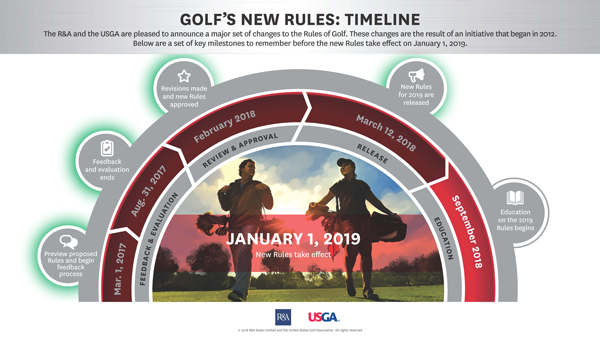New Golf Rules are Player-Friendly
by Rob Lundgren
Player-friendly. Modern. Sensible. These are the most common responses one hears in Idaho when asking about golf’s proposed Rules changes.
For over five years the United States Golf Association (USGA) along with The Royal & Ancient Golf Club worked on an extensive overhaul of the Rules of golf. The proposed changes were announced in March 2017 and golfers were given the opportunity to study and comment on them until August 31 of last year. Now the new Rules have been finalized and will go into effect January 1, 2019.

So far, Idaho golfers, whether professional or amateur, seem to be embracing the changes. “This was long overdue,” says Russ Peterson, longtime leader of the IGA’s Course Rating department and who served as the interim executive director of the IGA over the winter before Adam McCormick accepted the position. “It was absolutely a good idea making the rules simpler for the average player to understand. They’re more player-friendly too.”
Peterson also indicated that most of the feedback his office has received has been positive. “I think most are in favor of them,” he said. “They like the simpler language for sure.” While admitting he may not like every proposed change, Peterson believes having rules are key. “They’re part of any sport or game,” he said. “I personally don’t like the designated hitter in baseball, but it’s a rule.”
Two of the changes Peterson likes are the option of leaving the flagstick in while putting and the one that involves penalty areas. “That new rule will allow courses more freedom in marking,” he said. “They will be given discretion to mark any penalty area (formerly known as a hazard area) as red so that lateral relief is always allowed.”
Ron Rawls, PGA head professional at Crane Creek Country Club in Boise and member of the national Board of Directors for the PGA of America, also likes the proposed changes.
“I like the USGA’s willingness to look at the Rules from the players’ perspective,” he said. “I think they want to make the rules easier to understand and to simplify them. Some of them make a lot of sense.”
One of those changes concerns leaving the flagstick in while putting. “I think that rule alone will help speed up the pace of play,” Rawls maintain.
Rawls also echoed the player-friendly aspect of the new rules, but hopes enough time is given to iron out any kinks they may have. “The new rules aren’t so intimidating for the players to learn,” he said. “They’re easier to understand and that makes the game more fun to play. I just hope the USGA gives time to evaluate how they are working and if something doesn’t make sense then make some changes.”
Scott Nicholes, PGA head pro at Ridgecrest Golf Club in Nampa, agrees. “We need to let these new rules play out and see what happens,” he said. “Hopefully we’ll get consistent working with them and the USGA won’t want to change them for awhile.”
One of the proposed changes Nicholes really likes is no penalty for accidentally moving a lost ball while in the process of looking for it. “It gives the players more freedom, because it allows them the freedom to actively seek their golf ball without penalty,” he points out. Nicholes also likes the new rule which allows players to repair “almost anything” on the green. “That’s a great rule,” he said. “All golfers want a smooth surface to putt on.”
Matt Grenrood has been golfing since he was six years old. Now in his early 20s, he’s working at his favorite part-time job – an assistant in the pro shop at Lakeview Golf Club in Meridian. Like Nicholes, he likes the new rule not penalizing the golfer if a lost ball moves while looking for it. “I think that’s very fair,” he says. “A lot of things can happen that are totally accidental like moving your ball in that situation.”
Grenrood also agrees with the wait-and-see attitude of most of the golfers he’s talked with about the changes. “I think a lot of the new rules revolve around the idea of being aware of what you’re doing on the course,” he said, “and we won’t know exactly how well the new rules will work until they go into effect.”
Avid amateur Steve Jessup is “pretty happy” with most of the proposed changes, especially the one dealing with dropping the golf ball. “It’s not really a drop because now you’ll be able to get as close to the ground without actually touching it,” he said. “It’s a simplification and it increases the pace of play.”
Another rule change he especially likes will allow the player to repair spike marks on the green. “I was in a tournament last year and had to putt over some pretty severe spike marks,” recalled Jessup. “Not being able to repair them was just stupid.”
One rule Jessup would like changed involves the out-of-bounds penalty. “I still don’t like it,” he said. “I’d rather take a drop where the ball crosses the out-of-bounds line, add a penalty stroke, and hit from there rather than going back to the tee box.”
Maybe next time, Steve?
Rob Lundgren is a freelance golf writer and frequent contributor to this publication. He lives in Meridian, Idaho.






